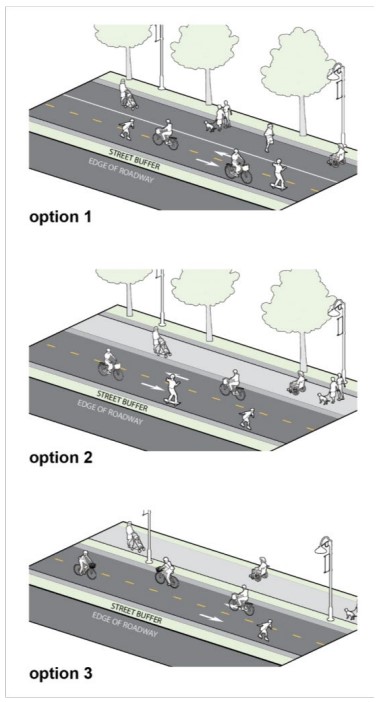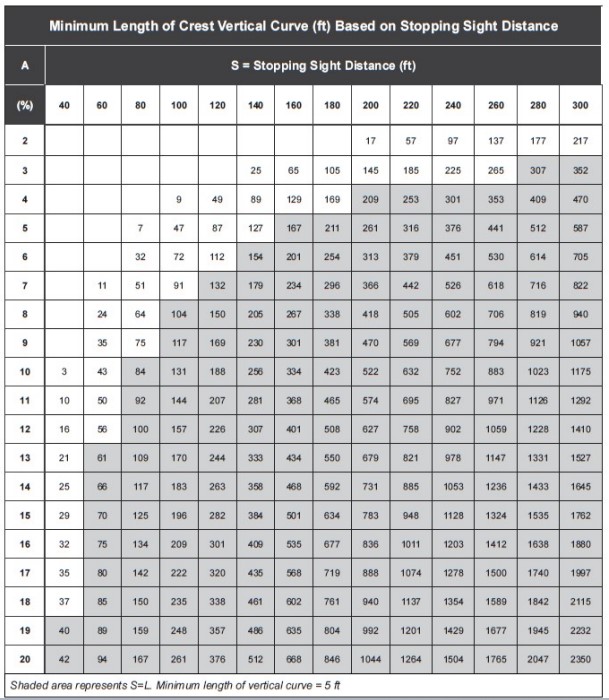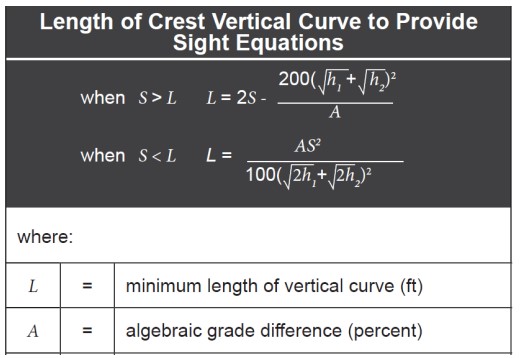18.4.1 Shared Use Paths Adjacent to Roadways (Sidepaths)

Figure 18-15: Example Shared Use Path Section
Shared Use Paths adjacent to roadways are located within a roadway corridor following the roadway alignment (hence the term sidepath) and are physically separated from motorized vehicular traffic by a landscaped buffer or a barrier. Sidepaths are generally designed for two-way travel, because in addition to bicyclists, users are likely to include inline skaters, skateboarders, pedestrians, and other micromobility or personal mobility device users. Sidepaths which do not provide adequate width may increase crash risk between people on the path.
Conflict points occur between motorists and path users at intersections and driveways. Of particular challenge is the contra-flow movement of higher speed users such as bicyclists. Conflict points should therefore be minimized and mitigated to the greatest extent practicable to maximize the comfort and safety of users operating on the facility (see
). The consolidation of driveways will reduce conflicts within the corridor.
Shared use paths may also be constructed with an independent alignment from a roadway which typically limits conflict points to midblock crossings of roadways. The shared use path on an independent alignment allows the vehicular driver to address the conflicts of the bicyclists exclusively, before proceeding to the roadway intersection and then addressing the standard conflicts with other vehicular traffic.
While the following guidance is written from the perspective of sidepaths located within roadway corridors, it is also applicable to shared use paths in independent alignments. Shared use paths in independent alignments often have fewer conflict points than sidepaths, however they may require the provision of more access points to provide connectivity to desired origins and destinations. The most common shared use path locations are through public property, parks, and abandoned railroad corridors. The
should be reviewed for additional guidance of shared use paths in independent alignments.
Refer to
for additional guidance on Shared Use Paths.
18.4.1.1 Application
Sidepaths are particularly useful when roadway width is limited and providing an on-street bikeway is not feasible. However, before defaulting to a sidepath, careful consideration should be given to potential conflicts between pedestrians and bicyclists as it is usually preferable to use separated bike lanes with sidewalks in urban areas and other locations where pedestrian volume is likely to result in conflicts between bicyclists and pedestrians as discussed in the width guidance.
For roadways with high driveway density, frequent street crossings, or overall high driveway volumes a one-way bicycle facility may be a more appropriate option, with an appropriate facility provided on each side of the roadway to provide needed origin and destination points. One-way bicycle facility preferred options include a separated or buffered bike lane. As identified in the
, for longer distances on urban and suburban streets with a considerable number of driveways and street crossings, two-way sidepaths can create operational concerns. Additional consideration should also be given with respect to parking configurations in the driveway vicinity that may tend to obstruct the sidepath usage or sight lines.
18.4.1.2 Width
When selecting a sidepath width, designers should consider the anticipated user volumes and mode split (bicycles, pedestrians, runners, etc.). The
is a helpful tool to inform a decision regarding the width of a path.
The Inputs into the SUPLOS calculator include the path width, trail user volume (one direction), trail user mix (mode split), and presence of a centerline stripe. The output is the calculated SUPLOS. A SUPLOS of “C” or better is desirable over the life of the facility to ensure it is comfortable and safe for all users.
provides an example calculation and set of typical inputs.
As a starting point for a new facility (without a shared use path), bike and pedestrian counts should be taken during the anticipated peak hour period on the existing roadway, and/or an analogous parallel facility which may provide a component of latent demand for the new shared use path. A reasonable factor should be applied for anticipated future growth of share use path usage. The
contains pedestrian and bicyclist count data for various types of facilities statewide and can be used to supplement missing information.
The desired width for a sidepath may range from 11-ft to 15-ft or more, depending on the SUPLOS calculation. These widths will accommodate higher user volumes while minimizing conflicts between them (based on the SUPLOS output). On a 12-ft sidepath, three “lanes” of users can operate simultaneously, allowing people to operate side-by-side while being passed by a person in the other direction (see
). To maximize service life and to assure a reasonable SUPLOS grade, paved widths should not be less than 10-ft.
As path user volumes increase, designers should consider increasing the width of the sidepath up to 15-ft. As path widths begin to exceed 15-ft in width, it may be desirable to separate pedestrians from bicyclists into sidewalk and separated bike lanes to minimize speed differential between pedestrians and wheeled users. Where it is determined to separate bicyclists and other higher-speed wheeled users from pedestrians (including people walking or using wheelchairs or other assistive devices) there are three primary strategies which can be considered for separating users on the facility (see
):
- A wide path can be provided which separates users using pavement markings
- A wide path can be provided which separates users with a traversable surface delineation;
- Separate paths can be used which are physical separated from each other.
Alternatively, a separate bicycle facility type may be selected.

Figure 18-16: Potential Options for Separation of Shared Use Paths
The standard
minimum width
is 10-ft. A minimum width
of 8-ft may be used in rare circumstances where all the following conditions are met:- Bicycle traffic is expected to be low (< 50 bicyclists/hour) during peak hours on the path;
- Pedestrian use of the facility is not expected to be more than occasional or less than 30% of total path traffic;
- Horizontal and vertical alignments provide frequent, well-designed passing and resting opportunities where the width is at least 10-ft; and
- The path will not be regularly subjected to maintenance vehicle loading conditions that would cause pavement edge damage.
In
constrained conditions
, a minimum width of 8-ft may be used for short distances to avoid physical constraints such as bridge abutments, utility structures, and environmental constraints.Segment Name | Path Width | Centerline | Volume (users per hour in 1 direction) and Mode Split | ||||||
Name | Width (ft | 1=Center-line | One-Way (per hour) | Adult Bicyclists | Peds | Runners | In-Line Skaters | Child Bicyclists | SUPLOS grade |
More Peds | 12.0 | 0 | 100.0 | 20.0% | 60.0% | 15.0% | 2.0% | 3.0% | C |
18.4.1.2.1 Street Buffer Width and Considerations
The space between the inside edge of sidepath and adjacent edge of outside travel lane (uncurbed), or face-of-curb (if curbed) is the street buffer. It is desirable to provide as much distance from the road as is practicable given project conditions.
The
minimum street buffer
is shown in
Roadway and Speed Condition | Minimum Street Buffer |
Curbed low-speed (45 mph or less) | 4-ft from FOC 1 |
Curbed high-speed (50 mph or greater) | 6-ft from FOC 1 |
Uncurbed all speeds | 10-ft |
Notes: | |
1. For curb and gutter sections with a shoulder, bike lane or any buffer in addition to the curb offset the minimum street buffer measurement begins at the edge of through travel lane (through travel lanes do not include turn lanes, accel lanes, or decel lanes). This minimum width is 10-ft. The required minimum street buffer for the sidepath then becomes the lesser of the 10-ft measurement, or the face of curb (FOC) minimum in Table 18-6. | |
The desirable street buffer would be the respective desirable clear zone values from
. Increasing the buffer width in the vicinity of driveways provides better alignment and visibility and is beneficial to all users.
A minimum shy space of 2-ft should be provided to intermittent (e.g., signs, streetlights, and utility poles) and continuous (e.g., walls, railings, fences, and barriers) vertical objects to minimize crash risks and increase the comfort of path users. Where space is available, wider shy spaces are desirable. In constrained conditions, the shy space may be reduced to 1-ft except to post mounted signs.
A graded shoulder with a minimum 2-ft width, 5- ft desirable, and a maximum cross-slope of 1V:6H should be provided on both sides of all shared use paths where natural terrain is present adjacent to the path alignment.
Where a bikeway is adjacent to a hazardous condition such as a parallel body of water or steep downward slope, a shoulder between the bikeway and the top of the slope of 5-ft is desirable. For steep slopes where the shoulder is less than 5-ft, physical barriers or rails are recommended in
. Specific railing considerations for bicyclists are provided in
.
18.4.1.2.2 Signing and Marking
Signs installed in the vicinity of sidepaths shall be installed in accordance with the applicable
criteria.
The
requires that no portion of a sign or its support be placed within 2-ft laterally from the near edge of a shared use path. Where space is available, wider shy spaces are desirable.
Refer to
– Section 9C.03 Marking Patterns and Colors on Shared Use Paths for information about markings for sidepaths. Additional information is provided in
regarding mid-block shared use path crossings.
18.4.1.2.3 Bicyclist Design Speed
A target design speed of 15 mph is generally appropriate to accommodate bicyclists on a shared use sidepath given the fact bicyclists are operating with pedestrians and may encounter driveways and intersections due to the alignment alongside the roadway.
For shared use paths with lower volumes of users expected now and in the future, a design speed of 18 to 30 mph may be appropriate where pedestrian volumes are low (less than 30 percent). The primary purpose of the shared use path is to provide a higher speed bicycling opportunity between destinations.
On unpaved path surfaces, bicyclists tend to travel slower to compensate for reduced braking ability, so a lower design speed of 12 mph may be used.
18.4.1.2.4 Cross Slope and Grade
Cross slopes of 1 to 1.5% percent are more comfortable for people with disabilities and people bicycling with more than two wheels (e.g., cargo bike, adult tricycles, or trailers). To meet pedestrian accessibility guidelines the cross slope cannot exceed 2.0 percent.
For shared use paths on independent alignments, longitudinal grades must meet pedestrian accessibility guidelines as they are expected users of the facility.
provides minimum design guidance for pedestrian accessibility of shared use paths.
reinforces that grades on shared use paths on an independent alignment are limited to 5 percent to maximize pedestrian accessibility.
Certain conditions such as physical constraints (existing terrain or infrastructure, notable natural features, etc.) or regulatory constraints (endangered species, the environment, etc.) may prevent full compliance with the 5 percent maximum grade. In those cases, mitigations should be considered to assist pedestrians. Grades may also exceed 5 percent at overpasses and underpasses if ramps and landings complying with
, Section R407, are provided.Options to mitigate excessive grades on shared use paths include the following:
- Use higher bicycle design speeds for horizontal and vertical alignments, stopping sight distance, and other geometric features;
- When steep grades occur over a long distance, consider an additional 4 to 6-ft of width to permit slower bicyclists to dismount and walk uphill, and to provide more maneuvering space for faster downhill bicyclists (see );
- Install the Hill Warning Sign for Bicyclists (W7-5) and advisory speed plaque in conditions where the steep grade is unexpected and not visible;
- Exceed minimum shy distances, add recovery areas and/or protective railings;
- If other designs are not practicable, use a series of short switchbacks to traverse the grade. If this is done, an extra 4-ft to 6-ft of path width is recommended to provide maneuvering space at each horizontal curve used to form the switchback;
- Provide resting intervals with flatter grades to permit users to stop periodically and rest; and
- Consider the provision of accessible pedestrian handrails.
Note
: Grades steeper than 3 percent may not be practical for shared use paths with crushed stone or other unpaved surfaces for both bicycle handling and drainage erosion reasons.When shared use paths follow the same alignment of the roadway, the sidepath grades will typically match the grade of that adjacent roadway. A sidepath within the roadway ROW of a road with a grade that exceeds 5 percent may not exceed the adjacent roadway grade.
18.4.1.3 Horizontal Geometric Design
provides the minimum radii for horizontal curves for paved shared use paths for various design speeds. These values use a 20-degree lean angle.
In general, a greater than 60-ft radii is preferred for horizontal alignment. For Shared Use Paths 10-ft or less in width in constrained locations where environmental or physical constraints limit the ability to apply a 60-ft radius, slower design speeds (12 to 16 mph) may be appropriate to allow the use of sharper horizontal curves to minimize impacts; however, the design should not result in a path with continuous combination of sharper curve. In these situations, wider paths or curve widenings of 2-ft to 4-ft should be considered to let users navigate the effects of substandard curves.
The
should be consulted where it is desired to develop curves using the superelevation method keeping in mind that shared use paths must meet accessibility guidelines which limit cross slopes to a maximum of 2.0 percent
Design Speed (mph) | Minimum Radius (ft) |
8 | 12 |
10 | 18 |
12 | 27 |
14 | 36 |
15 | 41 |
16 | 47 |
18 | 60 |
20 | 74 |
25 | 115 |
30 | 166 |
18.4.1.4 Vertical Geometric Design
provides the vertical curve length needed based on stopping sight distance and algebraic grade difference on crest vertical curves.
provides the equation for calculating this length for scenarios not shown in
. A recumbent bicyclist is recommended to establish design criteria and the following assumptions should be used:
- The eye height of the recumbent bicyclists is 3.83-ft; and
- The object height is at the ground surface (i.e., 0-in) to recognize that impediments to bicycle travel can exist at pavement level.
Table 18-8: Minimum Vertical Curve Length Based on Stopping Sight Distance

Table 18-9: Crest Vertical Curve Equation

18.4.1.5 Other Considerations
Crashworthy barriers, when used on locations with sidepaths, should be located between the roadway and sidepath. A minimum of 1-ft of shy distance is needed between the vehicular traffic and the barrier, and between the sidepath traffic and the barrier.
On roadways which do not have roadside obstacles requiring a barrier, a barrier or railing may be considered to improve path user safety where the facility has all these conditions present:
- The road is uncurbed;The road is uncurbed;
- If shoulders are present, the road has shoulders less than 4-ft in width; and
- The road is a high-speed facility.
provides additional details on the design of barriers and railings. Designers should see
for further details on bridges and underpasses for shared use paths
To improve the safety of contra-flow bicyclists who may be unexpected by motorists, the following measures should be considered during design:
- Provision of 6 to 20-ft street buffers at crossings to create space for motorists to stop and yield to path users while turning;
- Provision of clear sight lines allowing motorist to see approaching bicyclists, pedestrians, and motorists;
- Provision of traffic control signs, and clearly marked bicycle crossings following (Part 9) to alert motorists of bicycle travel;
- Reduction and consolidation of driveways to the greatest extent practicable to reduce conflict points;
- Constructing driveways at sidewalk level to emphasize bicycle use along a sidepath to motorists entering/exiting driveways to slow turning motorists and improve their likelihood of stopping and yielding to crossing path users; and
- At signalized intersections consider:
- Provide a leading interval or phase separation to minimize conflicts where path volume exceeds 100-150 users/hour and right turning vehicle volume exceeds 100 vehicles/hour;
- Provide a leading interval or phase separation to minimize conflicts where path volume exceeds 100-150 users/hour and left turning vehicle volume exceeds 50 vehicles/hour or roadway operating speeds exceed 35 mph; and
- Prohibit right turns on red where vehicles frequently block the crosswalk.
Each end of a sidepath should directly connect to an on-street bike facility, another trail or path, or to a bicycle-compatible local street. Where no interconnecting bikeways exist, advanced signage should be installed informing roadway users that the path ends, and bikes may use the full lane. Additional signage in conformity with
can be provided that directs bicyclists to interim facilities along alternate routes.
The minimum vertical clearance to obstructions over the path that may be used in constrained areas is 8-ft. The desirable vertical clearance to obstructions is 10-ft. In some situations, vertical clearance greater than 10-ft may be needed to permit passage of maintenance and emergency vehicles, or where equestrian use may be expected.